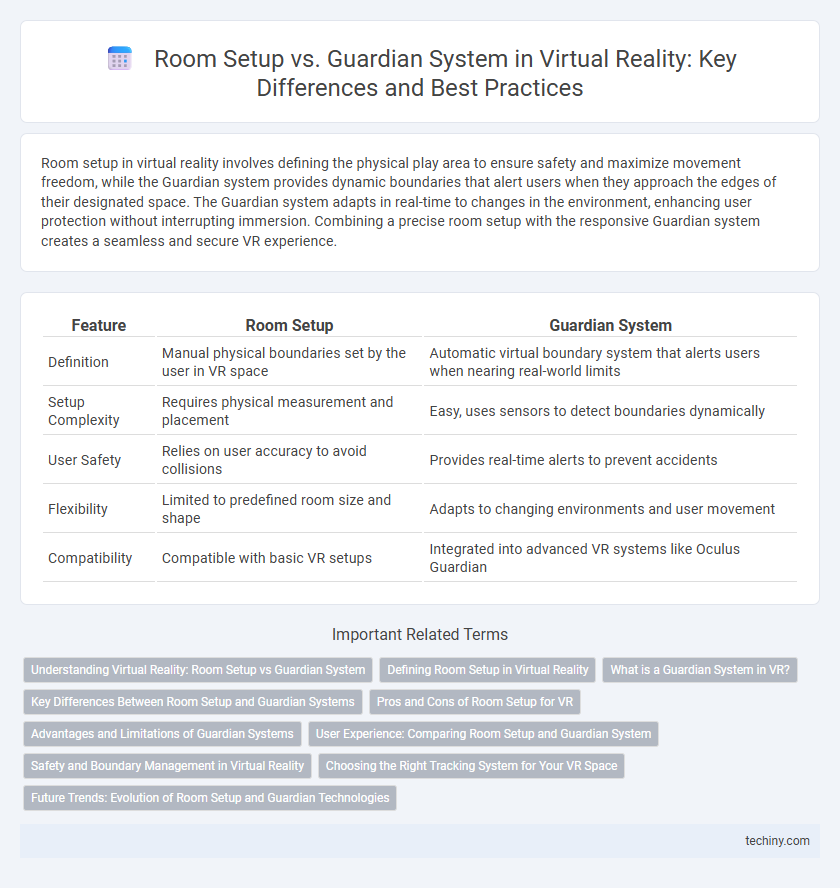Room setup in virtual reality involves defining the physical play area to ensure safety and maximize movement freedom, while the Guardian system provides dynamic boundaries that alert users when they approach the edges of their designated space. The Guardian system adapts in real-time to changes in the environment, enhancing user protection without interrupting immersion. Combining a precise room setup with the responsive Guardian system creates a seamless and secure VR experience.
Table of Comparison
| Feature | Room Setup | Guardian System |
|---|---|---|
| Definition | Manual physical boundaries set by the user in VR space | Automatic virtual boundary system that alerts users when nearing real-world limits |
| Setup Complexity | Requires physical measurement and placement | Easy, uses sensors to detect boundaries dynamically |
| User Safety | Relies on user accuracy to avoid collisions | Provides real-time alerts to prevent accidents |
| Flexibility | Limited to predefined room size and shape | Adapts to changing environments and user movement |
| Compatibility | Compatible with basic VR setups | Integrated into advanced VR systems like Oculus Guardian |
Understanding Virtual Reality: Room Setup vs Guardian System
Virtual Reality room setup involves defining a physical play area to ensure safe interaction within the virtual environment, using spatial mapping to track user movements accurately. The Guardian System acts as a dynamic boundary within this setup, alerting users when they approach real-world obstacles to prevent collisions. Understanding the interplay between room setup and the Guardian System optimizes safety and immersion by balancing spatial awareness with seamless virtual navigation.
Defining Room Setup in Virtual Reality
Room Setup in Virtual Reality involves mapping the physical play area to ensure safe movement and interaction within the virtual environment. This process captures room boundaries, objects, and obstacles, allowing the VR system to translate real-world dimensions accurately into the virtual space. Defining Room Setup enhances immersion and prevents collisions by dynamically adjusting virtual boundaries in response to user movements.
What is a Guardian System in VR?
A Guardian System in VR is a safety feature that creates a virtual boundary to prevent users from physically colliding with real-world objects during immersive experiences. It uses sensors and cameras to map the play area, alerting users with visual or haptic feedback when approaching the edge of the designated safe zone. This system enhances user safety by minimizing the risk of accidents while maintaining freedom of movement within the virtual environment.
Key Differences Between Room Setup and Guardian Systems
Room Setup in virtual reality defines physical boundaries by calibrating play space dimensions, ensuring users have clear spatial awareness during VR sessions. The Guardian System creates dynamic protective virtual barriers that warn users when approaching real-world obstacles, preventing collisions in real time. Key differences include Room Setup's static boundary definition versus Guardian's adaptive, real-time safety notifications, optimizing user immersion and safety.
Pros and Cons of Room Setup for VR
Room Setup in VR offers a more natural and immersive experience by allowing users to freely move within a physical space, enhancing spatial awareness and interaction fidelity. However, it requires ample clear area and can pose safety risks if boundaries are not well-defined, leading to potential collisions with real-world objects. Unlike the Guardian System, which provides a virtual boundary to prevent accidents, Room Setup depends heavily on meticulous physical space preparation and user vigilance.
Advantages and Limitations of Guardian Systems
Guardian systems in virtual reality offer clear boundary definition to prevent users from colliding with real-world objects, enhancing safety during immersive sessions. They automatically create virtual perimeters based on sensors, eliminating the need for manual room setup and allowing flexible play areas adaptable to varying environments. However, limitations include potential glitches in boundary detection and reliance on sensor accuracy, which may result in users inadvertently crossing physical obstacles if the system calibration is off.
User Experience: Comparing Room Setup and Guardian System
Room Setup offers a customizable spatial boundary for VR users, creating a precise play area tailored to physical room dimensions, while the Guardian System automatically generates safe zones to prevent collisions with real-world objects. User experience with Room Setup emphasizes flexibility and personal control, suited for static environments, whereas the Guardian System enhances safety in dynamic or varied spaces by providing real-time protective feedback. Both systems aim to balance immersion and safety, but the Guardian System's adaptive alerts often result in fewer disruptions during active gameplay.
Safety and Boundary Management in Virtual Reality
The Room Setup establishes the physical play area dimensions for virtual reality experiences, defining the safe space users can move within to prevent collisions with real-world objects. The Guardian System enhances safety by projecting virtual boundaries once users approach the edge of the designated play area, providing real-time visual warnings to avoid accidental falls or impacts. Together, these systems ensure effective boundary management, minimizing physical risks and improving user immersion during VR sessions.
Choosing the Right Tracking System for Your VR Space
When selecting the ideal tracking system for your VR space, consider the trade-offs between Room Setup and Guardian System options. Room Setup provides precise external tracking using sensors or cameras placed around a physical play area, offering expansive movement and increased immersion for large spaces. Guardian Systems rely on software-defined boundaries to prevent collisions, making them easier to configure for smaller or irregular spaces while prioritizing user safety over extensive tracking range.
Future Trends: Evolution of Room Setup and Guardian Technologies
Room setup and Guardian systems are rapidly evolving with advancements in spatial mapping, AI-driven environment recognition, and enhanced user safety protocols. Future trends indicate seamless integration of adaptive boundary systems that dynamically adjust to changing room conditions, minimizing collision risks and optimizing immersive experiences. Emerging technologies also emphasize cross-platform compatibility and cloud-based environments, enabling more flexible and scalable virtual reality setups.
Room Setup vs Guardian System Infographic

 techiny.com
techiny.com